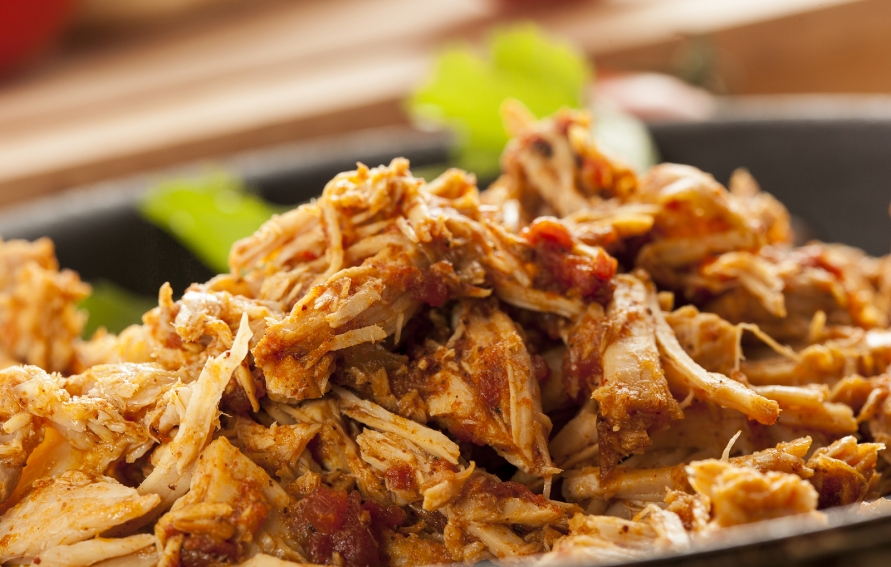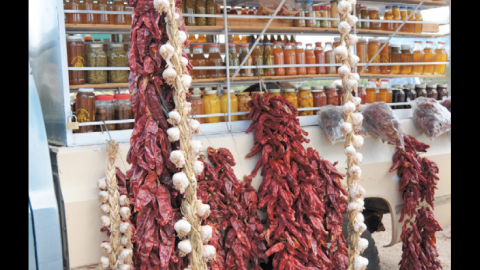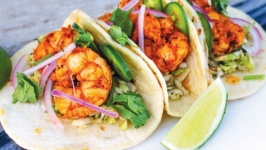Ingredients
- 1½ cups shredded carne machaca
- 2 cups water
- 4 red chiltepines, dried and crushed
- 2 tablespoons extra-virgin olive oil
- 8–12 green chiltepines, chopped
- 3 tablespoons dried Mexican oregano
- 1 cup grilled and diced nopales*
- 2–3 cups chopped wild quelite amaranth (pigweed) leaves**
- 1 medium white onion, peeled and diced
- 1 garlic clove, peeled and sliced paper-thin
- 1 sprig cilantro
- 6–8 tomatillos, husks removed, coarsely chopped
Preparation
Soak the shredded meat in the water with the red chiltepines, one hour to overnight. Drain off the excess water. Alternatively, simply simmer for about 10 minutes.
Cooking
Heat the oil in a sauté pan over medium heat and sauté the green chiltepines, being careful about the fumes, which can burn or choke you if directly inhaled. Add the oregano, grilled nopales, amaranth leaves, onion, garlic and cilantro, stirring until the onion is browned.
Add the tomatillos and soaked meat and continue to cook, stirring, for another 5 minutes or until the tomatillos have softened. Taste for salt, although usually the dried meat provides plenty.
Serve with flour tortillas and a side of pinto or tepary beans.
One of the reasons chiles gained popularity around the globe so quickly after being brought to the Old World from the New is their usefulness as a preservative for meat. Of course, drying meat had already long been a practice in these same cultures; combining the two strategies must have seemed what we now refer to as a no-brainer.
This recipe is, in a sense, a more rustic (and genuine) version of the fajitas popularized in modern chain restaurants across the United States. It utilizes machaca, a form of dried beef brisket popular in the Sonoran Desert of north-central Mexico and southern Arizona. It is, in essence, what Americans would call jerky. My grandpa used to call it "cowboy meat" due to its ubiquitous presence in saddlebags in the Old West. It retains its popularity for similar uses to this day. For purposes such as the recipe below, it is widely available pre-shredded.
Gary's fondness for this dish of his adopted homeland, which he affectionately refers to as "The Stinkin' Hot Desert," mandates its inclusion here, but it would have been necessary anyway for its foundational use of the cherished chiltepin in two forms–dry and red as well as fresh and green. Adjust the heat level to your tastes by adding or omitting as many as you wish.
*A note about nopales–the leaves or pads of the genus Opuntia from the Cactaceae family, or what is commonly known as the prickly pear cactus. It is widely available in bodegas and should be obtained as fresh as possible. Spring and summer are the common harvest times, so look for them then. Wash them thoroughly and boil or grill them for any number of uses. The boiled option often produces a certain mucilaginous texture many people find objectionable, so my preference is grilled.
**And about the amaranth: The leaves are a common vegetable throughout many parts of Africa, Asia and Central and South America. It is often referred to as pigweed, and is quite tasty and nutritious. If it is unavailable, you might substitute less authentic (but still delicious) spinach leaves.
Recipe from Chasing Chiles: Hot Spots Along the Pepper Trail by Kurt Michael Friese, Kraig Kraft and Gary Paul Nabhan, Chelsea Green Publishing, March 2011.








